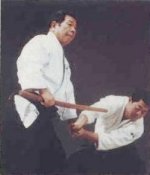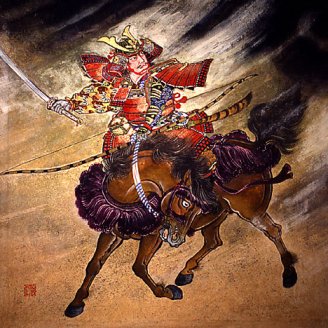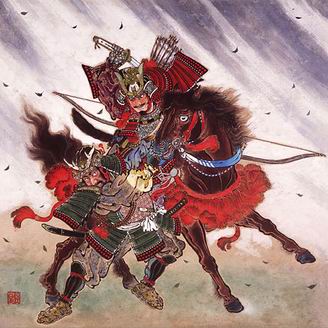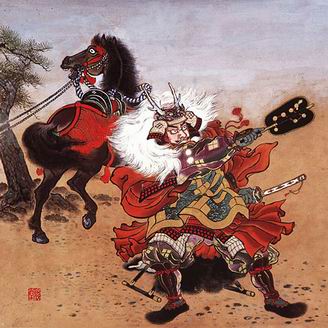
Saito Sensei with his son...
|
|
| Schedule |
| Evening |
| Monday |
19:30 - 21:00 |
| Tuesday |
19:30 - 21:00 |
| Wednesday |
19:30 - 21:00 |
| Thursday |
19:30 - 21:00 |
| Friday |
19:30 - 21:00 |
| Saturday |
11:00 - 12:30 |
| Sunday |
- |
| Morning |
| Monday |
07:00 - 08:00 |
| Tuesday |
07:00 - 08:00 |
| Wednesday |
07:00 - 08:00 |
| Thursday |
07:00 - 08:00 |
| Friday |
07:00 - 08:00 |
Aiki Shuren Dojo Istanbul
�elebi Mehmet Cad. Atasoy Apt. No:20 Emniyetevleri 4. Levent /
Istanbul
Turkiye
For information about Dojo:
Av. Mehmet S. Dogu
Office: +90 212 234 51 83
|
|
What is aikido? (CONT.)
Aikido's fundamental principle is to blend with an opponent's movement and energy, controlling their physical center while protecting one's own center from reversal. One never fights strength and aggression with the same, but instead relies on more refined techniques and methods, such as body movement, joint locks, off balancing methods, throws, controlling techniques, vital point attacks and of course blending of movement and energy (aiki) to effortlessly redirect and control an opponent's attack.
The Roots & History of Aikido
Unfortunately, the exact origin of Aikido and the forms that serve as it's foundation are not documented reliably, so there are several popular theorys, or versions that circulate today. From extensive research, the following accounting appears to be a reasonable conclusion.
 Yorimitsu Minamoto
Yorimitsu Minamoto
In it's earliest form, it is believed that the term Aikido was first used by a well known Samurai named Yoshimitsu Shinra Saburo Minamoto of Teseiwagenji han, approximately 900 years ago. It is said that Yoshimitsu dissected and analyzed the bodies of criminals and war dead at Daito Mansion, and with this understanding of body and skeletal mechanics based the Daito ryu style of jujutsu. Yoshimitsu passed the art to his son Yoshimitsu Yoshikiya, who later moved to Takeda region of Japan. the family resided in Takeda (Kai province) from the 1500's to the late 1800's and assumed the family name of "Takeda".
 Minamoto No Yoriyoshi
Minamoto No Yoriyoshi
Takeda Sokaku and The Daito Ryu influence on aikido
Originally, Aikijutsu had been developed as a combat art based primarily on the Toso techniques (sword and spear) to be used on battlefields against other Bushi (soldiers) wearing armor. At the time, Jujutsu was practiced as a secondary study. Within Jujutsu was a second level of training called Aiki no jutsu (Aikijujutsu) that was reserved for the higher ranking Samurai. The Jujutsu Techniques could be used offensively, while Aiki no jutsu was strictly a defensive art. The techniques evolved with the needs of the times and were handed down eventually to the Takeda family in Kai province as a "gotenjutsu", or martial arts for use inside a palace, and later, Takeda Kumitsugu passed the teachings to the Aizu han (clan). After Daito ryu passed to Aizu han, the top retainers, lords and generals need Aiki no jutsu (also called "oshikiuchi". There is some question as to whether or not this term refered to the martial techniques or to ways of ettiquette) as a means of self-defense inside the Aizu castle (seen mostly as suwariwaza and hanmi handachi). Masayuki Hochina, an instructor of the fourth Tokugawa Shogunate at Edo castle, is said to have completed development of Oshikiuchi, which was later combined with Takeda family Gotenjutsu in the Meiji period to become modern day Daito ryu.
 Sokaku Takeda
Sokaku Takeda
"The purpose of this art (Daito ryu) is not to be killed, not to be struck, not to be kicked, and we will not strike, will not kick, and will not kill. It is completely for self-defense. We can handle opponents expediently, utilizing their own power, through their own aggression. So even women and children can use it. However, it is taught only to respectable people. It's misuse would be frightening..." -- Takeda Sokaku
 Takeda Shingen
Takeda Shingen
Takeda Sokaku was raised in the Meijo era (1868-1912). During this time, major changes were occurring (The Meiji restoration) throughout Japan that involved the assimilation of western ways and the expansion of international trade agreements, as well as the elimination of "Samurai" status, to insure that all people would be treated equally. Among changes made during the Meiji restoration was, in 1876, a ban on the wearing of swords publicly. Seeing the effects of these new changes, Takeda Sokaku understood that there would be a need to modify the emphasis of Daito ryu jujutsu (techniques of kuminchi were known as "Daito ryu Jujutsu" until about 1922. Research indicates that "Aiki" was added later at the suggestion of Omoto-Kyo leader, Deguchi Onisaburo) from that of primarily being a Kenjutsu (sword) based art, to Aikibujutsu; which focused more on Taijutsu (unarmed techniques). As a result of these changes, and Sokaku's willingness to spread this previously guarded art form to the general public, the revised Daito ryu became very popular and Sokaku was crowned with the success of his idea. As an interesting side note, Takeda Sensei preferred to travel throughout Japan teaching to groups of students at a time (where he is said to have demonstrated techniques to his students, rather than actually instruct in great detail) and never settled in a single dojo for any great length of time. According to his extensive enrollment books, records indicate that Takeda taught as many as 30000 students throughout his life.
 Takeda Shingen
Takeda Shingen
Morihei Ueshiba's "Takemusu Aikido"
Takeda Sokaku produced several outstanding martial artists during his life, among the best being Ueshiba Morihei, founder of modern day Aikido. Morihei Ueshiba (O-Sensei) trained and taught Daito ryu Aikijujutsu diligently during the years before WWII (pre-war period), while at the same time developing his Aikido style. After the war, O-Sensei resumed teaching Aikido in Iwama, which he continously modified and refined until the time of his death in 1969. Morihiro SAITO, one of Ueshiba's most recognized students, studied seriously for 23 years until O-Sensei's death, being the only student who stayed that long with O-Sensei during founder's prime at his experience when O-Sensei organized the empty-handed and weapon's techniques of his aikido; Iwama-ryu takemusu aikido.
|
|
TERMS
Iwama Shinshin Aiki Shuren Kai
Iwama Ryu Takemusu Aikido Organization
Ai Hanmi
Same or matched stance
Aiki Jo
The Staff of Aikido
Aiki Ken
The Sword of Aikido
Aikikai Hombu Dojo
World Headquarters of largest aikido organization
Atemi
Strike to a vital point
Bokken
Wooden Sword
Daito-ryu Aikijujutsu
Jujutsu school and the technical precursor of aikido
Deguchi, Onisaburo (1871-1948)
Spiritual leader of the Omoto religious sect who had a strong influence on the thinking of Morihei Ueshiba
Gyaku Hanmi
Reverse or opposite stance
Henka
Change, variation
Henkawaza
Variation (technique)
Ikkyo
First teaching
Jo
Staff
Katadori
Shoulder grab
Katatedori
One-hand grab
Ken
Sword
Ki
Spirit or energy
Kobukan Dojo
Name of the prewar school of Morihei Ueshiba located in the Shinjuku district of Tokyo
Kokyuho
Breathing way or method; series of exercices to develop breathing, ki extension, and a stable posture
Kosadori
Cross-handed grab
Kuden
Oral teaching
Morotedori
Two-hand grab (Two hands on one)
Munadori
Chest grab
Nikyo
Second teaching
O-Sensei
lit, "great teacher," term of respect used to refer to Morihei Ueshiba
Omote
Front; refers to entering movements
Omotokyo
Shinto-based religious sect which flourished in Japan in the early part of the 20th century
Oyouwaza
Applied technique
Ryotedori
Two-hand grab (one hand on one)
Sankyo
Third teaching
Shomenuchi
Frontal head strike
Sodedori
Sleeve grab (at elbow level)
Sodeguchidori
Cuff grab
Suwariwaza
Seated technique
Tai no henko
Body change or shift; exercise to develop ability to turn properly
Taijutsu
Body technique; i.e., technique executed empty handed
Takeda, Sokaku (1859-1943)
Disseminator of Daito-ryu aikijujutsu and main martial arts teacher of Morihei Ueshiba
Takemusu Aiki
lit., "aiki, progenitor of martial techniques"; refer to the highestlevel of spotaneous execution of aikido techniques
Tegatana
Hand blade
Ueshiba, Morihei (1883-1969)
Founder of Aikido
Ura
Back, reverse; refers to turning or pivoting movements
Ushiro
Rear
Yokomenuchi
Lateral head strike
Yonkyo
Fourth teaching
|
|
|